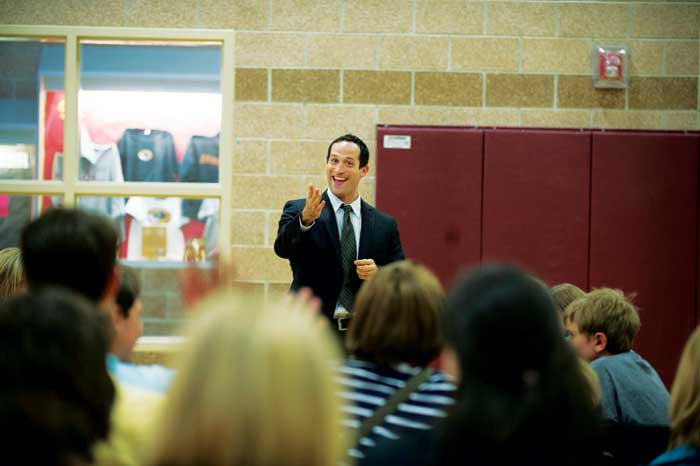
At a June meeting, principal of the new high school in Northfield Avi Tropper enthusiastically answers questions about the IB program that will be used at the school. The campus has been named after Paul Sandoval but the board has not yet voted on the high school name.
Springtime was a season full of fresh ideas for change in the Denver Public School (DPS) system. In Northeast Denver, these proposals elicited controversy across the Northfield, East, Manual, and George Washington High School communities.
Why all the changes?
DPS Superintendent Tom Boasberg says he understands that parents have very real concerns about their own children and DPS needs to “listen, acknowledge and understand” those concerns. However, particular concerns over the rigor of programs, access to quality schools, and services available to individual students must be considered within a larger context. DPS “continues to see very large gaps on virtually all academic measures between our white students and our African American and Latino students—gaps that remain large even when the economic circumstances of our students are taken into account.” Boasberg contends: “The achievement gap remains our nation’s biggest civil wrong. We need to make it right.”
The Proposals
Plans for the new Northfield High School (NHS) are proactively targeted to address opportunity and achievement gaps that plague the district. DPS has reiterated that all Stapleton students are guaranteed a seat at the high school. They have also made an unwavering commitment to ensure diversity by drawing school boundaries to include neighboring communities. The Boundary Advisory Group, consisting of community members across the Northeast, recommended that 35 percent of the seats at NHS be reserved for choice and, within that 35 percent first priority be given to all residents of the far Northeast, then residents in Park Hill who are part of the shared middle-school boundary and who qualify for Free and Reduced Lunch (FRL), and next, FRL students across the city—and the school board recently approved these recommendations. Furthermore, NHS will institute the IB program as a schoolwide curriculum, where all students are engaged in rigorous 9th- and 10th-grade preparatory courses and where all students have an opportunity to participate in the 11th- and 12th-grade IB Diploma program.

A protester holds a sign opposing the East-Manual partnership.
A proposed East-Manual High School partnership was presented to more than 200 attendees at a community meeting at East High School on Tuesday, May 27. This partnership would, starting in 2016, take the form of a 9th-grade academy that would combine all East and Manual freshman into a single cohort taking classes together on Manual’s campus. Graduates of the academy would have the choice to return to East for a comprehensive 10th–12th-grade high school experience or they could opt to attend what will become Manual’s 10th–12th-grade Science, Technology, Engineering, and Math program. This East-Manual partnership is just one proposed solution that the district is considering to address the low enrollment and retention at Manual and to ease overcrowding at East while providing a wider array of opportunities for East students.
The George Washington (GW) community recently learned that in the 2015-16 school year, GW will no longer feature a selective admissions program for its International Baccalaureate (IB) diploma program. In its present configuration, the IB program screens students in the eighth grade and admits students who qualify into a rigorous pre-IB program for the 9th- and 10th-grade years. Those students then go on to pursue the IB diploma during 11th and 12th grades.
DPS communications staff explain that doing away with the selective admissions process for the pre-IB program and strengthening the honors, Advanced Placement, and Career & Technical Education programs are necessary changes to improve the “academic and overall school experience for all students.” What’s more, the district hopes that by strengthening an array of programs, combining IB hopefuls in honors classes with other GW students during the ninth and tenth grades, and permitting more choice between programs, GW will attract some of the nearly 67 percent of high-school-age students within their boundary who presently choice out.
The Objections
Stapleton residents, despite repeated assurances from DPS and Principal Avi Tropper, continue to worry that there will not be enough space at NHS for DPS to guarantee a seat to every student in the neighborhood and ensure a diverse student body. At the May 7 boundary meeting, moreover, residents of the far Northeast voiced strong objections to high percentages of FRL set-asides. Jimmy Alexander, a parent from Green Valley Ranch, put it bluntly: “How stereotypical can you be? Not one of the African American families here qualifies for FRL,” suggesting that conflating racial diversity with low socioeconomic status would result in lost opportunity for middle-class families in the far Northeast. The committee and the board listened to this concern and opened the boundary equally to all far Northeast students regardless of FRL status.
The East-Manual proposal raised a host of concerns for attendees at the community meeting. Some were concerned about students’ social and academic development, others worried about services for special-needs students, still others wondered how sports teams would be impacted by the East-Manual partnership. Rob Robertson’s question, however, drew the loudest applause: “DPS has a lot of problems. What problem are you actually trying to fix here?” Another parent followed up, asking: “Is this to save Manual, is that the point of doing this, because it’s failing and we don’t want to leave those kids out?” Principal Andy Mendelsberg’s response to this line of inquiry remained consistent: “I don’t see [the partnership] as saving anything. I see it as giving kids access and opportunities. And I think we can do that.” Several parents expressed frustration with Mendelsberg’s consistent “more opportunities” refrain. But Mendelsberg’s promotion of more and “different opportunities, different access points” is one of the prime ways DPS plans to suture its achievement gaps.
The GW proposals were also met with heated opposition. As Lisa Sigler, a parent of an IB student at GW recalls, the crowd gathered at the May 10 meeting with DPS to discuss changes to the IB program was “extremely emotional. People were angry.” Parents who objected to the changes at GW felt that DPS had made the decision to alter one of its most academically successful programs without consulting those families affected by the change. “There was very little stakeholder input,” argues Sigler. Sigler’s daughter, Kate, addressed the June 12 Board of Education meeting, informing members that “the elimination of the pre-IB program saddens” her and makes her “lose hope that DPS has the best interests of its students in mind.” Both Kate Sigler and her mother feel that the solution to GW’s low enrollment should not be an “either or, but a both”—the Siglers advocate keeping GW’s IB program as it is and also strengthening the school’s other programs.
The Vision: Quality and Diversity
Superintendent Boasberg says there is no clear path to balancing the needs of DPS’s wide-ranging student body. While he acknowledges “there are absolutely times when it is important to group kids by level,” he also does not “believe that we should have systems that are so rigid in the way kids are grouped that they…resemble the failed tracking programs of the past.” The district “cares deeply about the quality and rigor of a child’s education and the ability to have diversity in our community.” Quality and diversity, Superintendent Boasberg reminds, “are not at odds with each other. That is the mission of our schools: to celebrate and make real the promise that quality and diversity are complements of each other. They support each other.”




0 Comments